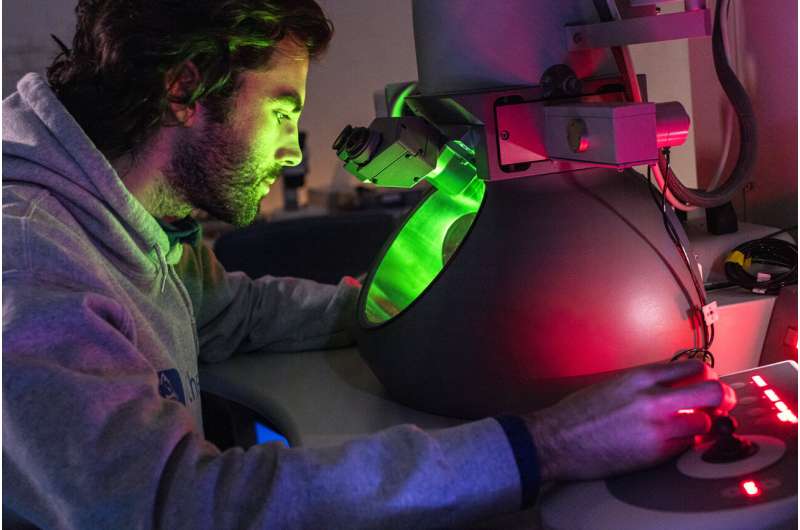This article has been reviewed according to Science X's editorial process and policies. Editors have highlighted the following attributes while ensuring the content's credibility:
fact-checked
peer-reviewed publication
trusted source
proofread
Nanoscale movies shed light on one barrier to a clean energy future

Left unchecked, corrosion can rust out cars and pipes, take down buildings and bridges, and eat away at our monuments. Corrosion can also damage devices that could be key to a clean energy future. And now, Duke University researchers have captured extreme close-ups of that process in action.
"By studying how and why renewable energy devices break down over time, we might be able to extend their lifetime," said chemistry professor and senior author Ivan Moreno-Hernandez.
In his lab at Duke sits a miniature version of one such device. Called an electrolyzer, it separates hydrogen out of water, using electricity to power the reaction.
When the electricity to power electrolysis comes from renewable sources such as wind or solar, the hydrogen gas it churns out is considered a promising source of clean fuel, because it takes no fossil fuels to produce and it burns without creating any planet-warming carbon dioxide.
A number of countries have plans to scale up their production of so-called "green hydrogen" to help curb their dependence on fossil fuels, particularly in industries like steel- and cement-making.
But before hydrogen can go mainstream, some big obstacles need to be overcome.
Part of the trouble is electrolyzers require rare metal catalysts to function, and these are prone to corrosion. They're not the same after a year of operation than they were in the beginning.
In a study published April 10 in the Journal of the American Chemical Society, Moreno-Hernandez and his Ph.D. student Avery Vigil used a technique called liquid phase transmission electron microscopy to study the complex chemical reactions that go on between these catalysts and their environment that cause them to decay.
You might remember from high school that to make hydrogen gas, an electrolyzer splits water into its constituent hydrogen and oxygen molecules. For the current study, the team focused on a catalyst called ruthenium dioxide that speeds up the oxygen half of the reaction, since that's the bottleneck in the process.
"We essentially put these materials through a stress test," Vigil said.
They zapped nanocrystals of ruthenium dioxide with high-energy radiation, and then watched the changes wrought by the acidic environment inside the cell.
To take pictures of such tiny objects, they used a transmission electron microscope, which shoots a beam of electrons through nanocrystals suspended inside a super-thin pocket of liquid to create time-lapse images of the chemistry taking place at 10 frames per second.
The result: desktop-worthy close-ups of virus-sized crystals, more than a thousand times finer than a human hair, as they get oxidized and dissolve into the acidic liquid around them.
"We're actually able to see the process of this catalyst breaking down with nanoscale resolution," Moreno-Hernandez said.
Over the course of five minutes, the crystals broke down fast enough to "render a real device useless in a matter of hours," Vigil said.
Zooming in hundreds of thousands of times, the videos reveal subtle defects in the crystals' 3D shapes that create areas of strain, causing some to break down faster than others.
By minimizing such imperfections, the researchers say it could one day be possible to design renewable energy devices that last two to three times longer than they currently do.
"So instead of being stable for, say, two years, an electrolyzer could last six years. That could have a massive impact on renewable technologies," Moreno-Hernandez said.
More information: S. Avery Vigil et al, Dissolution Heterogeneity Observed in Anisotropic Ruthenium Dioxide Nanocrystals via Liquid-Phase Transmission Electron Microscopy, Journal of the American Chemical Society (2024). DOI: 10.1021/jacs.3c13709
Journal information: Journal of the American Chemical Society
Provided by Duke University





















